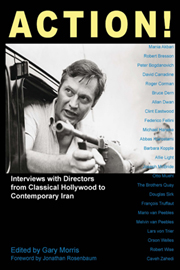Book contents
- Frontmatter
- Contents
- Foreword, by Jonathan Rosenbaum
- Editor's Preface
- Acknowledgements
- Introduction: The Art and Craft of Interviewing
- I Going Hollywood: Masters of Studio Style
- II Tickets to the Dark Side: Festival Favorites
- 6 Manderlay: Lars von Trier
- 7 20 Angosht (20 Fingers): Mania Akbari
- 8 I Am a Sex Addict: Caveh Zahedi
- 9 Caché (Hidden): Michael Haneke
- III Blows Against the Empire: Indie Godfathers
- IV Edgeplay: Avant-Garde Auteurs
- V Women in Revolt: Artist-Activists
- VI The Canon: Brilliance without Borders
- Contributor Biographies
9 - Caché (Hidden): Michael Haneke
from II - Tickets to the Dark Side: Festival Favorites
Published online by Cambridge University Press: 05 March 2012
- Frontmatter
- Contents
- Foreword, by Jonathan Rosenbaum
- Editor's Preface
- Acknowledgements
- Introduction: The Art and Craft of Interviewing
- I Going Hollywood: Masters of Studio Style
- II Tickets to the Dark Side: Festival Favorites
- 6 Manderlay: Lars von Trier
- 7 20 Angosht (20 Fingers): Mania Akbari
- 8 I Am a Sex Addict: Caveh Zahedi
- 9 Caché (Hidden): Michael Haneke
- III Blows Against the Empire: Indie Godfathers
- IV Edgeplay: Avant-Garde Auteurs
- V Women in Revolt: Artist-Activists
- VI The Canon: Brilliance without Borders
- Contributor Biographies
Summary
“I wish you a disturbing evening!” This is how Michael Haneke (born 1942), who won Best Director award at Cannes in 2005 for Caché (Hidden), introduced his films one evening at a festival in London. Audiences–and their complacency towards the political conflicts “hidden” in the screen–are a prime target for this Austrian intellectual. Caché is a case in point. The story of a TV producer haunted by creepy cassettes, videos of his own house, sent him by an angry Algerian from his past, it boldly addresses the issue of firstworld seclusion from the third-world–and the collaboration of the media, and its audiences, to keep this issue hidden. As Haneke said at our interview in Cannes: “Each of us pulls the blanket over our heads and hopes that the nightmares won't be too bad.” Notably, the TV producer (played with tortured intensity by Daniel Auteuil) watches his own nightmares as if with a wide-angle lens.
We, as spectators, are also kept out. We watch the film through a distant camera, a reflection of our own alienated relation to the world around us. The closing shot of Caché is that of two boys, Michael Haneke (2004). Credit: Photofest Algerian and French, conversing on the steps of a school, a mute “dialogue” that we can only glimpse through a wide-angle shot of a grate.
Similarly, Haneke's best-known film, The Piano Teacher (2001), begins (as it ends) with a closed door.
- Type
- Chapter
- Information
- Action! , pp. 131 - 138Publisher: Anthem PressPrint publication year: 2009



